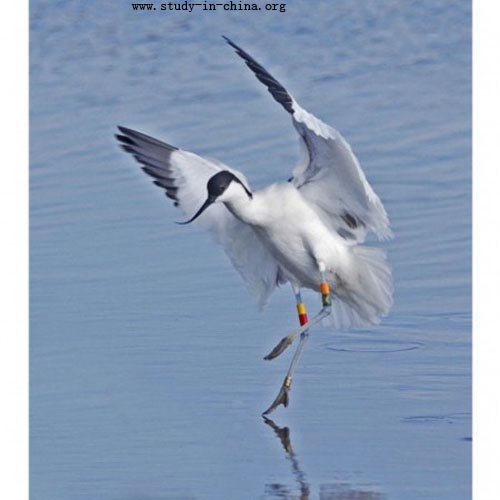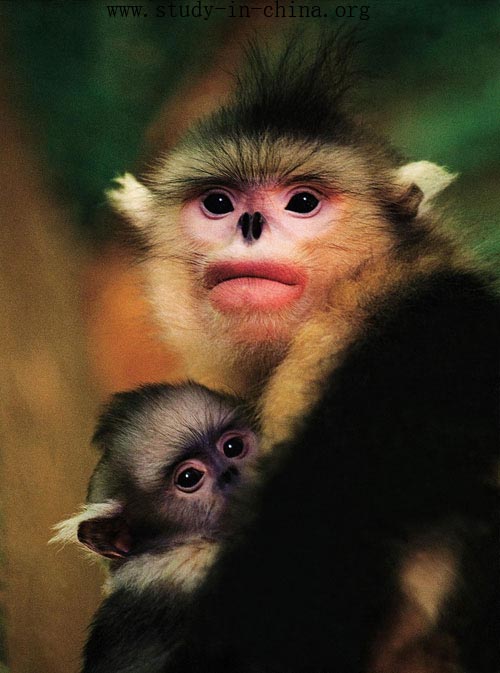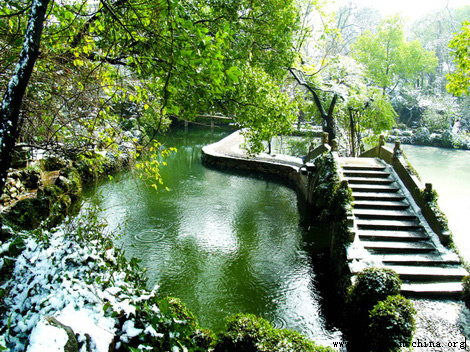| Home > Living In China |
Animal protection in China

ANCHOR: Located about 3,200 meters above sea level, Qinghai Lake in the northwest of the Qinghai-Tibet Plateau is China's biggest inland salt water lake and one of the country's key wetland areas. Due to its rich array of ecological resources, it ranks at number one among the top eight bird reserves in China, with the largest wetland area and the greatest variety of food, which in turn attracts a great number of migrantory birds each year. Unfortunately, the beauty of the reserve is now not only attracting birds, but also poachers, who came to kill and steal these rare species for their own profit. For the keepers of the reserve, protecting the birds from both natural disasters and human greed is proving to be a daunting task. Lin Lin has more on this.
REPORTER:
(ice melting, river flowing…)
Spring is the time when Qinghai Lake recovers from its frozen, lengthy winter. In March, when trees in most parts of the country begin to turn green, the Lake is still a vast expanse of white.
On the northern bank of the lake are the Naren Wetlands. Naren, in the local dialect, means perennial streams. The Naren Wetlands are home to tens of thousands of birds, of which many are endangered species. Every spring, hundreds of swans fly from Naren to migrate to neighboring Xinjiang or as far as Russia's Siberian region, to breed. Not long after they are gone, flocks of bar-headed geese, black-neck cranes, and egrets arrive for the coming summer.
Forty-two-year-old Jia Wu Cai Rang is a Tibetan herdsman. He has been recording information about the birds' arrivals and departures for decades.
"Last year I observed that when the black-neck cranes arrived, their feathers were really bad-looking. I could tell that they must have suffered a lot on the way here--- bad weather and environmental pollution alike. I hope that this time, they can take on a new look, and even bring their offspring."
For generations, Cai Rang's family has been living in the Naren Wetlands, alongside Qinghai Lake. For local residents, waterfowls are like the fairies of the Lake, who protect the safety and harvest of their homeland, and who also need a peaceful place to live. But unfortunately, since the 1990s, a lack of awareness regarding the protection of the birds, as well as insufficient management, has led to poachers encroaching on the peaceful atmosphere of the lake, where they have begun to make a living by killing, catching and selling birds.
To protect the birds, in 1985, Cai Rang became a volunteer for the Wetlands. His main job is to persuade people who intend to poach to give up, and if they insist on doing so, Cai Rang is to take action against them, such as registering their car plates or calling the police.
"I feel extremely outraged by those people who kill the innocent birds. When it comes to my job, I'm pretty strict. Even if they were my best friends, I wouldn't allow them to get too close to the birds, because I think the birds live in their own world and should not be disturbed by outsiders."
In 1997, Qinghai Lake was classified by the central government as a state-level natural reserve. This gave the resources of the Naren Wetlands, which sit right on the bank of the Lake, full protection.
Since 2001, the lake has prohibited fishing as part of the efforts to protect its environment, which have been ravaged by over-fishing. Cai Rang says he is not only guarding the safety of the wetland and its birds, but also taking care of injured birds as they can return to Mother Nature at an early date.
"I remembered once I picked up a sick black-neck crane during a heavy rainstorm. I took it back home, and started to feed it vegetables. At first, it was cautious in its new home, and kept crying all day and night. Its voice was loud and harsh. But gradually, it seemed that it realized I was not going to hurt it. The crane recovered quickly. Three days later, I sent it to the local management bureau for rehabilitation. When I returned home and saw an empty house, I felt like I had suffered a loss."
Cai Rang regards the birds as his family members. Whenever he has time, he goes to the reserve to visit his friends. He sometimes distributes food through the fields, to help some birds survive food shortages. Back home, on his self-designed-and-made monitoring charts, he keeps all his records, including the number of the birds, their behavior patterns and which birds are living there. From his careful observations, he has determined that the number of birds coming and choosing to stay are increasing at a steady pace.
"The population of wild birds is growing. Take black-neck cranes as an example. In 2007, I observed 36 cranes. In 2008, over the same period of time, I saw 44. In 2009, the number expanded to 71. In addition, in Naren, I've detected three crane species that have made their permanent homes here, out of a total of 15 crane species worldwide. Starting last year, I found Ciconia nigras were nesting and laying their eggs in the Wetland. It is a rarely seen bird here. I was very excited. That proved that my efforts have not been in vain, and the wetland environment is improving."
During the past 26 years, Cai Rang has treated and cured more than 10 water-fowls. In the Qinghai Lake area, birds species have grown from 164 in the 1990s to the present 191. In peak seasons, tens of thousands of birds make the place a heaven for birds.
Among many local people, Cai Rang is considered the guardian of birds.
"Birds have their own languages. I can imitate different sounds.(ambiences…) I use this method to communicate with them. I have also won their trust. They are not scared if I stand very close to them. I can stand at a very close distance and watch the cranes dance and chase after one another. I sometimes feel like I am one of them."

ANCHOR:
The Yunnan snub-nosed monkey is one of the iconic animals of Yunan in southwestern China. They get their name from their short stumpy nose and live in high-altitude forests between 3,000 to 4,500 meters above sea-level. They are therefore considered to be the most elusive of the world’s monkeys. In the 1890s, French scientists first reported the existence of the Yunnan snub-nosed monkey. But in the following decades, they were not seen again, giving rise to suspicions that the monkey had become extinct. They were sighted again in 1993 by which time the population of the species had fallen to about 1,000.
REPORTER:
Eighteen years after the rare species was re-discovered, Xi Zhinong's memories of that day are still fresh. That year, he, as China's leading wildlife photographer, along with an expedition team from the Chinese Academy of Sciences, was among the densely-populated snow-capped mountains seeking traces of the monkey. By the time Xi saw them, he and his colleagues had been in the mountains for over a year.
"One week after we began searching the nearby mountains, we decided to return to our headquarters on the mountainside. We felt extremely exhausted and frustrated that we hadn't been able to find any monkeys. But on our way back, a group of snub-nosed monkeys showed up on our radar screen."
Xi Zhinong recalls that the monkeys they saw were a family, taking a rest. The father monkey was sitting on the tree trunk, with a pine cone in his hand. Two mother monkeys were leaning next to him, and one was holding a lovely baby monkey in her arms. All of a sudden, the photographer burst into tears.
"The Yunnan snub-nosed monkeys are among the primate species which inhabit high-altitude mountain forests. They live far far away from the human world so we know very little about them. Even among scientists, a lot of information about them remains a mystery."
The pictures shot by Xi Zhinong gave zoologists and animal protection groups confidence that the endangered animal was still alive and they confirmed the young man's belief that he could use his camera to protect endangered animals. Xi's interest in wildlife photography has gradually transformed him into an environmentalist.
In 1995, the county government in Deqing intended to chop down some 100 square kilometers of primitive forests to develop the local travel service. It was believed that the forest was home to more than 200 Yunnan snub-nosed monkeys. Right after Xi Zhinong learnt of the logging plans, he wrote to the central government, caustically describing the proposal as "short-sighted and committing a sin against future generations". The plan was eventually terminated. Then in 2001, about 20 square kilometers of the forest was put under the protection of the expanded national forest reserve, which covers a total area of 190 square kilometers. But unfortunately for Xi Zhinong, he was dismissed from his government post. He later moved to Beijing and founded Wild China Film, an environmental protection group which advocates promoting public awareness through photography.
"I enjoyed the feeling of working in the wild. Going to bed upon sunset, and waking up with sunrise gave me a wonderful feeling. When you're there it's hard to imagine how people can live in cities."
Xi Zhinong believes public awareness regarding animal protection should be cultivated and well-guided. He takes his own experience as an example. He recalls that when he was a small kid, he loved catching birds and made them into birds specimens.
"At that time, I didn't have a chance to read books about animal protection. I used catapults to catch birds, and later, a gun to shoot them. I loved birds, but my way of loving birds was to take them down and turn them into specimens."
Being an environmentalist and a wildlife photographer, Xi Zhinong has witnessed a change to his own attitudes about how to best appreciate animals.
"A delicate specimen is made at the cost of the life of the bird. Life is the most valuable part of any species despite how pretty a specimen may look, because without life there is no spirit. Unlike specimens, wildlife photography can create the most vibrant and precious images of those animals, in a way that does not disturb their lives. It allows people to share the happiness they find in nature without jeopardizing the lives of the animals they love. I think that's really why I founded my film studio - to record the life of those animals, and their increasing struggle for survival against both the forces of nature and humankind."
In most of Xi Zhinong's works, the animals are looking steadily at the camera as if they were posing for photographers. Xi Zhinong explains that it needs years of fieldwork experience, as well as familiarity with their habits to be able to catch those fleeting moments to shoot the best image. To achieve this goal, Xi Zhinong has to spend most of his time in the wild, often walking on his knees or bending down amongst the plants, waiting for these breathtaking moments.
Xi Zhinong says that because of human destruction of habitats and environmental degradation, the size of forests has been shrinking rapidly. Over the past forty years, inhabited areas fit for the monkey have deceased by more than 30 percent and the average living area for a snub-nosed monkey has dwindled to one third of the previous level, now at around five square kilometers per monkey. In this sense, Xi Zhinong says he can hardly tell whether his work is rewarding or not because he is witnessing the deterioration of their living environment. He still hopes his work can stoke more interest in these animals, and convince people to do what they can do to protect them.
"Being a wildlife photographer is destined to be a lonely career. Unlike a news journalist who should always compete against time for first-hand information, a wildlife photographer has to endure lengthy periods alone, so that he can be prepared for those unexpected photo opportunities."
Custom
 more
moreWeb Dictionary
Primary&secondary
Beijing National Day School
Beijing Concord College of Sino-Canada
Brief Introduction of BCCSC Established in the year 1993, Huijia School is a K-12 boarding priva...Beijing Huijia Private School





 print
print  email
email  Favorite
Favorite  Transtlate
Transtlate 







